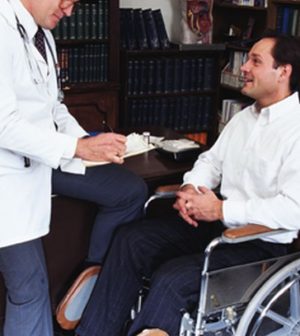- Understanding the Connection Between Anxiety and Depression
- How Daily Prunes Can Influence Cholesterol and Inflammation
- When to Take B12 for Better Absorption and Energy
- Epsom Salts: Health Benefits and Uses
- See What Saffron Can Do for Sleep and Heart Health
- 6 Common Mistakes to Avoid Before Your Physical
- Can Sweating Really Help You Beat a Cold?
- Strengthening Your Relationship: Practical Strategies
- Skip Storing This Everyday Product in the Fridge Door
- Green Tea + B3 Pairing May Boost Brain Health
Nerve Drug Might Curb Spinal Cord Damage, Mouse Study Suggests

The nerve pain drug gabapentin might reduce damage after a spinal cord injury, research in mice suggests.
The drug prevented harmful structural changes in injured spinal cords, as well as cardiovascular changes and immune suppression caused by spinal cord injury, according to the study.
“Gabapentin is often prescribed as a treatment for pain, but if it is given early after injury — before symptoms develop — it can also limit structural changes in nerve cells. We show that these benefits remain even one month after stopping gabapentin treatment in spinal-injured mice,” said study co-author Phillip Popovich, chair of neuroscience at Ohio State University.
“We believe that gabapentin could be repurposed as a prophylactic therapy that can prevent autonomic dysfunction in people affected by spinal cord injuries,” Popovich added in a school news release.
The autonomic nervous system controls involuntary processes such as heart rate and blood pressure.
“Autonomic dysfunction is a major problem for people living with a spinal cord injury. The cardiovascular complications can lead to severe morbidities like heart attack and stroke while long-term immune suppression can lead to serious recurrent infections like pneumonia,” said Popovich.
Currently, these symptoms can only be managed. There is no treatment.
“This is the first time a treatment has been shown to prevent the development of autonomic dysfunction, rather than manage the symptoms caused by autonomic dysfunction. In response to stress or danger, autonomic nerve cells in the spinal cord trigger a ‘fight or flight’ response. This is a normal and helpful response that increases blood pressure and releases hormones like adrenaline and cortisol,” said study lead author Faith Brennan, a research scientist at Ohio State.
But after a spinal cord injury, major structural changes occur within spinal autonomic nerve centers that control the fight or flight response, resulting in uncontrolled autonomic reflexes.
For example, normally harmless processes, such as the bladder filling, can trigger an uncontrolled fight or flight response that can lead to health problems such as severe high blood pressure, slowed heart rate and long-term immune suppression.
“The possibility of repurposing gabapentin … to prevent the development of autonomic dysfunction could significantly improve the quality of life for individuals living with spinal cord injuries, including greater independence in society, reduced caregiver reliance, reduced infection susceptibility and increased life expectancy,” Brennan said in the release.
However, research on animals does not always produce the same results in humans.
The study was published online Jan. 26 in the journal Cell Reports.
More information
The U.S. National Institute of Neurological Disorders and Stroke has more on spinal cord injury.
SOURCE: Ohio State University, news release, Jan. 26, 2021
Source: HealthDay
Copyright © 2026 HealthDay. All rights reserved.










